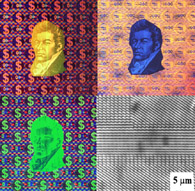
EXELGRAM anti-counterfeiting technology
1992
optical security technology for banknotes and documents
Counterfeiting of money is an age-old crime. It results in financial losses for governments and individuals.
The life of a counterfeiting criminal has become easier with advances in colour photocopying. Fake bank notes and other documents such as passports and visas can be produced using this technology, with excellent results.
One way to combat this problem is to place optically variable devices (OVDs) in banknotes, making them impossible to copy using a photocopier. Many credit cards carry holograms (a form of OVD) but they have not always prevented forgery. In 1993 alone Visa and Mastercard between them reported losses of up to $2 billion as a result of fake and forged cards.
CSIRO is leading the world in development of more sophisticated OVDs through its EXELGRAM technology. Dr Robert Lee invented the technology, which produces two quite different images depending on the angle it is viewed at. One of the main features of the technology is that it can reproduce photo-quality portraiture and have a positive?negative image flip effect. It can produce graphic effects with colours that switch on and off, and super high resolution micrographic effects. The technology is highly flexible and can incorporate new images and designs required by clients.
EXELGRAM technology has been used by American Express in its $US travellers cheques. In 1999, after two years of use, it was reported that the technology had led to an 89% decline in counterfeit activity. The remaining problem lay with the US$20 cheque, which did not bear an OVD. EXELGRAM was so successful that American Express introduced the technology to its new Euro travellers cheques.
The EXELGRAM technology is also being used on Hungarian, Estonian and New Zealand banknotes; Vietnamese bank cheques; Ukrainian visas; and Saudi Arabian security products.
Who Did It?
Key Organisations
CSIRO Division of Manufacturing Science and Technology: research
Leica Cambridge (UK) : development
Disctronics : development
Leonhard Kurz (Australia): commercialisation
Key People
Dr Bob Lee: inventor
Further Reading
EXELGRAM brochure
CSIRO Manufacturing Science and Technology
August 2000
Links
CSIRO
Manufacturing Science and Technology
CSIRO
media release, 17 June 1999
Secrets of Making
Money - $US
Related Innovations
Plastic banknotes
Passport security
|











